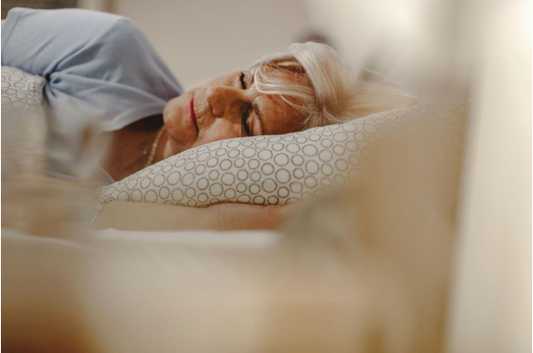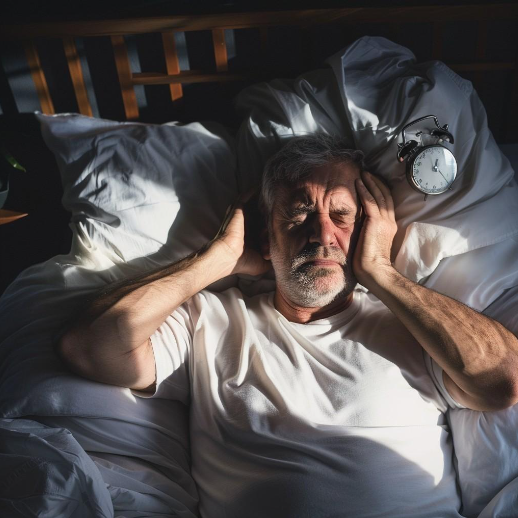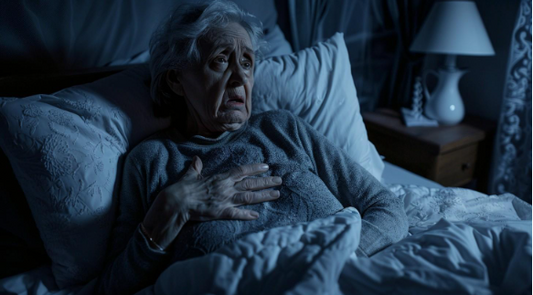Elderly insomnia is more than just an occasional sleepless night. For many, it's a persistent struggle that impacts health and daily life. However, the bedroom can hold a crucial key to unlocking better sleep. A well-thought-out sleep environment can transform restlessness into relaxation and offer a solution to sleepless nights. Simple changes, like adjusting lighting, controlling noise, and selecting comfortable bedding, can make a world of difference. This post will delve into practical steps you can take to create a peaceful and restful sanctuary for sleep, tailored specifically for older adults. Get ready to turn restless nights into restful slumber.
Understanding Insomnia in the Elderly
Insomnia, a struggle for restful sleep, is notably common among the elderly. It's like trying to find peace in the middle of a bustling city. Imagine lying wide awake while the world sleeps; this is the reality for many seniors. Insomnia strikes almost half of older adults, becoming a constant challenge that impacts daily life.
Common Causes of Insomnia
Understanding the root causes of insomnia can be like piecing together a puzzle. Several factors contribute to this condition in older adults:
- Medical Conditions: Chronic illnesses such as arthritis or diabetes can cause discomfort or frequent bathroom trips during the night.
- Medications: Certain prescriptions for heart disease, asthma, or depression may have side effects that disturb sleep.
- Psychological Issues: Stress, anxiety, or depression can keep the mind racing long after the body wants to rest.
Recognizing these elements is crucial. They underline the complexity of insomnia, making it clear this isn't just a matter of bedtime routine but a deeper issue intertwined with one's overall health.
Effects of Insomnia on Health
It's easy to underestimate insomnia's ripple effect on health; however, its impacts can be profound. Poor sleep is more than just an annoyance. Here's what it can mean for the elderly:
- Physical Health: Exhaustion from lack of sleep can lead to increased falls, weakened immune function, and even heart problems.
- Mental Health: Sleep deprivation can blur the mind. It heightens the risk of depression and anxiety and might exacerbate cognitive decline or dementia.
Insomnia is not just a nightly battle but a marathon with long-term implications. It serves as a wake-up call to prioritize sleep, recognizing it as a pillar of a healthy life, especially for seniors who value their independence and wellbeing.
In addressing these issues, creating a restful bedroom ambiance can be a game-changer. With simple changes, a serene slumber isn't out of reach.
Key Elements of a Restful Sleep Environment
Creating a perfect sleep environment is like painting a masterpiece. Each brushstroke adds to the overall picture, just like every element of your bedroom contributes to quality sleep. Especially for older adults, crafting a space conducive to rest can make all the difference in combating insomnia. Here's how to ensure your bedroom is setting you up for a night of blissful slumber.
Temperature Control
Ever tossed and turned, feeling too hot or too cold? The temperature of your room plays a crucial role in how well you sleep. Experts typically recommend keeping your bedroom between 60-67 degrees Fahrenheit. A cooler room signals to your body that it's time to sleep, mirroring the natural drop in temperature we experience at night.
To achieve this:
- Use a fan or air conditioning to keep the room cool.
- In colder months, a climate-controlled blanket can provide warmth without overheating.
-
Consider a programmable thermostat to adjust the temperature automatically at night.
Light Management
Light is the enemy of sleep. Your body's internal clock, or circadian rhythm, is heavily influenced by light, dictating when you feel alert and when you feel sleepy. Too much light in the bedroom can confuse these signals.
To manage light exposure:
- Install blackout curtains to block external light.
- Use dim, warm-toned lighting in the evening to mimic sunset.
- Avoid screens at least an hour before bed. If this is tough, try blue light-blocking glasses.
Noise Reduction
Just a small noise can disrupt your sleep, pulling you out of a deep slumber into a lighter sleep stage. For seniors, who may already experience fragmented sleep, minimizing noise is essential.
Here’s how to create a serene soundscape:
- Use earplugs if you’re sensitive to noise.
- Invest in a white noise machine or use a fan to drown out disturbances.
- Fix squeaky doors or floors and consider thick rugs to absorb sound.
Bedding and Comfort
Your bed is your nightly retreat, and its comfort level can make or break your sleep. Investing in the right materials for your mattress and pillows supports your body and enhances relaxation.
Consider these bedding tips:
- Choose a mattress that supports your spine. Memory foam or hybrid mattresses can offer the right mix of support and comfort.
- Select pillows that align with your sleep style. Side sleepers might need thicker pillows, while back sleepers benefit from flatter cushions.
- Soft, breathable sheets made from natural fibers like cotton or bamboo can improve comfort without overheating.
By focusing on these key elements, you're setting the stage for better sleep. Your bedroom isn't just a room; it's a sanctuary designed to recharge and refresh you overnight. When the environment is just right, sleep comes naturally, effortlessly wrapping you in rejuvenating rest.
Practical Tips for Creating a Sleep-Friendly Bedroom
Creating a peaceful bedroom environment is essential for improving sleep quality, especially for the elderly who may struggle with insomnia. Small changes can make a big difference in how well someone sleeps. Here are some tips to help transform a bedroom into a restful retreat.
Decluttering and Organizing
A tidy space can work wonders for relaxation. Clutter can create stress and distractions that keep the mind active, making it harder to fall asleep. Here are some practical steps to declutter and organize the bedroom:
- Clear Surfaces: Start by removing items from nightstands, dressers, and the floor. Keeping surfaces clear can create a sense of calm.
- Create a Storage System: Use baskets, bins, or shelves to keep items organized. Label bins to make finding things easier.
- Regular Clean-Up: Set aside time each week for a quick tidy-up. This prevents the buildup of clutter.
- Limit Decorations: While some decor can be soothing, too many decorations can be overstimulating. Choose a few favorite pieces to display.
A clean, organized space allows for a clearer mind, making it easier to unwind and prepare for sleep.
Incorporating Soothing Colors and Decor
The colors and decor in a bedroom play a vital role in promoting tranquility. Here are some ideas for creating a calming atmosphere:
- Choose Soft Colors: Opt for soft, muted tones like light blue, green, or pastel shades. These colors can evoke feelings of calmness and serenity.
- Natural Elements: Incorporate nature-inspired decor, like plants or
nature-themed artwork. Having green elements can create a more relaxed environment.
- Avoid Busy Patterns: Stick to simple patterns when choosing bedding or curtains. Loud, busy designs can be distracting rather than soothing.
- Use Soft Lighting: Incorporate dimmable lights or softer bulbs to create a calming ambiance in the evening. Avoid bright, harsh lights that can disrupt a relaxing mood.
By creating a visually soothing environment, it's easier to foster a mindset conducive to sleep.
Establishing a Bedtime Routine
A consistent bedtime routine signals the body that it’s time to wind down. Here are some calming activities to include:
- Reading a Book: Choose a light, enjoyable book to read for 15-30 minutes before bed. This can be a great way to transition into a sleepy state.
- Gentle Stretching or Yoga: Spend a few minutes doing gentle stretches to relax the body. This can relieve tension and prepare you for sleep.
- Meditation or Deep Breathing: Spend a few minutes focusing on your breath. Simple meditation can quiet the mind and help reduce anxiety.
-
Listening to Calming Music: Soft, soothing music can help create a peaceful atmosphere. Consider instrumental music or nature sounds.
A regular routine sets a calming tone for bedtime and helps signal to the body that it's time to sleep, making it easier to drift off into a deep slumber.
Conclusion
A well-designed sleep environment plays a crucial role in combating insomnia among the elderly. By focusing on factors such as comfort, light control, and noise reduction, you can significantly improve sleep quality.
Implementing the tips shared in this blog can help create a peaceful sanctuary for rest. Consider simple changes like adjusting the room temperature or using blackout curtains.
As you work on enhancing your sleep space, think about how these modifications might also boost your overall well-being. What steps will you take today to transform your bedroom into a restful retreat?
Thank you for reading, and feel free to share your thoughts or experiences on creating a better sleep environment.
P.S.
If you are having difficulty with sleeping, you are not alone. There are many folks out there who want to know what the most effective natural sleep aid is to get them back to snoozing again. Fix My Sleep is a great resource for all those who have trouble sleeping and are looking for innovative tips and sleep products to help them get a good night’s sleep.





